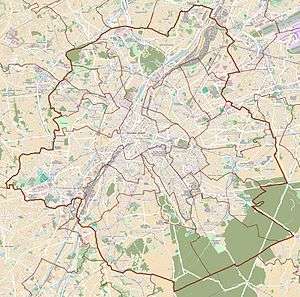Egmont Palace
The Egmont Palace (French: Palais d'Egmont, Dutch: Egmontpaleis) is a neoclassical palace in Brussels, Belgium. It is situated in the Sablon/Zavel district, between Rue aux Laines/Wolstraat and the Petit Sablon Square. Today, it houses the Belgian Ministry of Foreign Affairs.
| Egmont Palace | |
|---|---|
 The cour d'honneur | |
 Location within Brussels | |
| General information | |
| Type | Palace |
| Architectural style | Neoclassical |
| Town or city | Sablon/Zavel, City of Brussels, Brussels-Capital Region |
| Country | Belgium |
| Construction started | 1548 |
| Website | |
| Official website | |
History
The original mansion was built between 1548 and 1560 by Françoise of Luxembourg and her son, Lamoral, Count of Egmont, first in a Flemish Gothic, and later Renaissance style. The fabric was dramatically transformed in the 18th century, when the property passed onto the Arenberg family, and the building was clothed in a neoclassical style. The plans for this stage are attributed to the early advocate of neoclassicism, Giovanni Niccolò Servandoni. After a fire demolished the oldest part of the building in 1891, it was reconstructed in a uniform neoclassical style.
The venue hosted the fencing events for the 1920 Summer Olympics in the garden.[1] After World War I, the German Arenberg family was forced to sell the building to the City of Brussels. In 1964, it was sold to the Belgian state. In 1977, the Egmont pact on the Belgian state reform was signed in the Egmont Palace during the second administration of then Prime Minister of Belgium Leo Tindemans.
Since 1992, the palace has been listed as a protected monument.[2] Nowadays, it is used for receptions and meetings by the Belgian Ministry of Foreign Affairs and hosts many events organised by the Royal Institute for International Relations.
Gallery
.jpg)
The courtyard seen from Egmont Park 
The main staircase
References
External links

- Egmont Conference Centre
